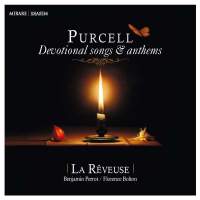Texte paru dans: / Appeared in: |
|
|
Outil de traduction ~ (Très approximatif) |
|
|
Reviewer: Bertil
van Boer The truism regarding English music is that Henry Purcell may have been the last great native composer before the 20th century. The rest, as they say, were foreign imports. Of course, this view has been altered completely with the rediscovery of the works of Thomas Arne, Maurice Green, Thomas Linley, and others, but it is interesting to note in the conventional world how this view still appears from time to time. Why is it that Purcell was such an imposing figure that subsequent composers, like Handel, were forced into some sort of competitive mode? The answer may be manifold, but it is clear that one of the reasons is that his musical style, while incorporating stylistic ideas from the French and Italians, was entirely original. And, it is possible that the prodigious amount of music written during his all-too-short life could be a factor, as was his sensitive use of the English language. This disc incorporates 10 of his anthems or devotional songs composed for a trio of voices and continuo. These pieces were composed when he was about 20 years old, making them some of his first forays into the world of sacred (or semi-sacred) music. They were no doubt meant for a private world, as they are musically intimate. Yet, the degree of difficulty makes it clear that they require a certain amount of professionalism, so their purpose is yet to be determined. Moreover, they were not published, which further provides proof that they were not meant particularly for a wider public. The poetry that Purcell chose to set is often dark and melancholic. “With sick and famish’d eyes,” written by George Herbert, for example, is filled with somewhat horrific imagery of a dying soul suffering from physical torments. The slow, funereal music is almost static, with chord changes occurring in long succession, while the voice hovers between arioso and recitative accompagnato. There is a chromatic ascent (with increased dynamics) at the end to the text “which dies,” perhaps the reverse of what one might expect and quite dramatic. In the song “Blessed is he” one can find the homophonic statements that seem like they belong to an Anglican service, half hymn and half strophic melody. When the text reads “The Lord shall deliver” the tenor embarks upon a rather challenging and florid line, almost an Italianate aria. This song ends with the doxology, likewise a display between each of the three voices in turn before combining in a virtuoso manner at the end, an exclamation of glory. The anthem Lord not to us is a gentle lament, a slow tune beseeching with urgent declamation the benediction of the Diety. It is mostly homophonic with the bass extending downward to some rather impressive lower registers. The final section surrounds some lovely descending suspensions. The Purcell trios are alone not quite long enough to fill a disc, so the program includes several pieces by a contemporary, Gottfried Finger (c. 1655–1730), one of Purcell’s contemporaries who originally hailed from Moravia. He apparently arrived in London about 1685 and was employed by the court of James II. He returned to the continent in 1702, where he embarked upon a career as an opera composer and viol virtuoso. Oddly enough, though he published his music regularly, his works for his own instrument never made it into print, save for his op. 1, a set of 12 sonatas for violin and gamba published in Amsterdam. In these, the last named instrument is often set independently, usually functioning as a foil for the rather virtuoso violin parts. In this disc there is a rather conventional sonata for his instrument that remained in manuscript. The work, while not being terribly innovative, does demonstrate the virtuosity that Finger was reputed to display. In the Allegro second movement, for example, there are several passages of double-stop suspensions that contrast with the rather florid portions. The other two pieces are entitled Diversions, meaning that they are more ground bass ostinatos than sonatas. The G-Major Division begins with the theorbo theme, and the gamba enters already with a first variation. As with most grounds, the upper voice is a series of increasingly florid and virtuoso variations. The G-Minor Division is more contemplative, a mournful theme that spins out gradually from its steady harmonic roots. The performance by the La Rêveuse ensemble is quite fine. Tenors Jeffrey Thompson and Marc Mauillon complement each other, one more resonant and the other lighter and more controlled. The bass of Geoffroy Buffière is full bodied and strong, especially in the lower registers required for the Purcell songs. They are accompanied by the continuo group of Pierre Gallon, alternating on the harpsichord and organ (depending upon the content of the text; the more introspective are on the latter), Florence Bolton on the gamba, and Benjamin Perrot on a theorbo, the last of which adds a nice tone to the bass line. The sound quality is excellent and both the phrasing and tempos are appropriate for the works. In all, this is a good disc to add to one’s collection.
| |
|
|
|
|
Cliquez l'un ou l'autre
bouton pour découvrir bien d'autres critiques de CD |
|




